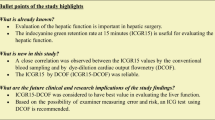Abstract
Objective
While using a transcutaneous system for assessment of liver function by indocyanine green plasma disappearance rate (ICG-PDR) in critically ill patients, we compared the agreement between ICG-PDR obtained by the recommended standard ICG dosage (0.5 mg/kg) and a reduced dosage (0.25 mg/kg).
Design
Clinical study.
Setting
Intensive care unit of a university hospital.
Patients
Critically ill patients (n=16, 5 female, 11 male) who underwent liver function monitoring by ICG-PDR for clinical indication.
Measurements and results
We analyzed 31 pairs of ICG-PDR measurements by applying the recommended dosage (0.5 mg/kg, ICG-PDR0.5) and a reduced dosage (0.25 mg/kg, ICG-PDR0.25). For each comparative measurement either first 0.5 mg/kg or 0.25 mg/kg of ICG was injected in a random fashion and followed by the corresponding dosage 60 min later. All patients were sedated and mechanically ventilated via a tracheal tube. Each patient was monitored by an ICG finger clip which was connected to a liver function monitoring system (LiMon, Pulsion Medical Systems, Germany). ICG-PDR0.25 was 2.7–25.0 %/min and ICG-PDR0.5 4.5–24.5 %/min, respectively. Linear regression analysis revealed ICG-PDR0.25=1.13·ICG-PDR0.5−0.66 %/min (r=0.95, p<0.0001) with a mean bias 1.0 %/min (standard deviation 2.5 %/min). The 15 min residual rates were also highly correlated (r=0.92, p<0.0001) with a mean bias of 0.3%.
Conclusion
A reduced dosage of ICG (0.25 mg/kg) is sufficiently accurate for transcutaneous measurement of ICG-PDR in critically ill patients.

Similar content being viewed by others
Reference
Sakka SG, Reinhart K, Meier-Hellmann A (2002) Prognostic value of the indocyanine green plasma disappearance rate in critically ill patients. Chest 122:1715–1720
Kholoussy AM, Pollack D, Matsumoto T (1984) Prognostic significance of indocyanine green clearance in critically ill surgical patients. Crit Care Med 12:115–116
Sakka SG, Reinhart K, Meier-Hellmann A (2001) Comparison of invasive and noninvasive measurements of indocyanine green plasma disappearance rate in critically ill patients with mechanical ventilation and stable hemodynamics. Intensive Care Med 26:1553–1556
Krenn CG, Schäfer B, Berlakovich GA, Steininger R, Steltzer H, Spiss CK (1998) Detection of graft non-function after liver transplantation by assessment of indocyanine green kinetics. Anesth Analg 87:34–36
Kimura S, Yoshioka T, Shibuya M, Sakano T, Tanaka R, Matsuyama S (2001) Indocyanine green elimination rate detects hepatocellular dysfunction early in septic shock and correlates with survival. Crit Care Med 29:1159–1163
Hashimoto M, Watanabe G (2000) Hepatic parenchymal cell volume and the indocyanine green tolerance test. J Surg Res 92:222–227
Lehmann C, Taymoorian K, Wauer H, Krausch D, Birnbaum J, Kox WJ (2000) Effects of the stable prostacyclin analogue iloprost on the plasma disappearance rate of indocyanine green in human septic shock. Intensive Care Med 26:1557–1560
Orii R, Sugawara Y, Hayashida M, Yamada Y, Chang K, Takayama T, Makunchi M, Manaoka K (2000) Effects of amrinone on ischaemia-reperfusion injury in cirrhotic patients undergoing hepatectomy: a comparative study with prostaglandin E1. Br J Anaesth 85:389–395
Devlin J, Ellis AE, McPeake J, Heaton N, Wendon JA, Williams R (1997) N-acetylcysteine improves indocyanine green extraction and oxygen transport during hepatic dysfunction. Crit Care Med 25:236–242
Sakka SG, Reinhart K, Wegscheider K, Meier-Hellmann A (2001) Variability of splanchnic blood flow in patients with sepsis. Intensive Care Med 27:1281–1287
Author information
Authors and Affiliations
Corresponding author
Rights and permissions
About this article
Cite this article
Sakka, S.G., Koeck, H. & Meier-Hellmann, A. Measurement of indocyanine green plasma disappearance rate by two different dosages. Intensive Care Med 30, 506–509 (2004). https://doi.org/10.1007/s00134-003-2091-6
Received:
Accepted:
Published:
Issue Date:
DOI: https://doi.org/10.1007/s00134-003-2091-6




